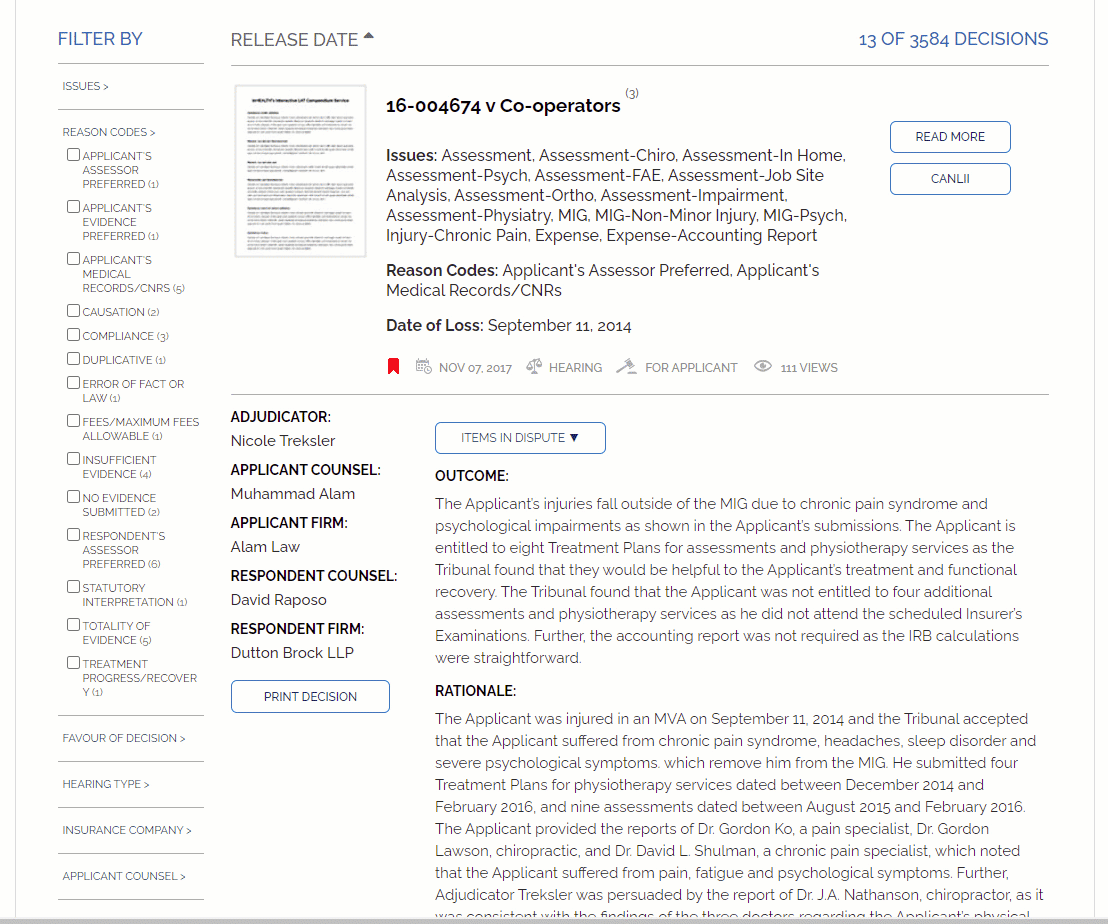
Volume. 6 Issue. 28 – July 20, 2022
This week’s edition considers a case wherein the Applicant sought a CAT determination as a result of his injuries suffered in a January 2016 accident, in context of his mother having already been rendered CAT as a result of her psychological reaction to his injuries. Ultimately, the Applicant, having fully consumed the available non-CAT limits was not found to be CAT, although he was confirmed as suffering from a complete inability to carry on a normal life, therefore was entitled to NEB to date and ongoing.
Reason Codes Are Here – Added Layer of Understanding!

Exciting News! Search and Filter by Reasons
Reason codes add a deeper layer of understanding on the reason for the decision and associated issues in dispute. This added value is included in all subscription levels at no extra cost.
Try It Now!
Book your walk-through with an inHEALTH team member by emailing service@inhealth.ca or send us a message through Live Chat!
Despite “Complete Inability” Ongoing, Applicant Not CAT
Not CAT but NEB Ongoing – Injured in a January 2016 accident, the Applicant, K.B., in 20-007082 v Unica, sought a CAT determination and entitlement to a number of benefits, including NEB at the rate of $320/week from May 29, 2019 to date and ongoing. K.B.’s medical history was notable in that he had been diagnosed with attention deficit hyperactivity disorder and Asperger’s syndrome, which causes impaired language and communication skills as well as repetitive or restrictive thinking and behaviour.
In the subject accident, it was agreed that K.B. had sustained significant permanent impairments, such that the non-CAT $50,000 limits had been exhausted by year end 2017. Of further note, K.B.’s mother, who had a pre-existing psychiatric history was rendered a CAT given that her condition had deteriorated significantly as a result of K.B.’s accident and injuries.
Unica’s CAT assessors found K.B. to have sustained a 44% Whole person Impairment (WPI), however the parties disagreed as to whether K.B. had sustained a psychological impairment that would result in a WPI of 55%.
K.B.’s assessor opined that K.B. had sustained marked impairments in the domains of activities of daily living, social functioning, and adaptation. K.B. was described by the assessor as leading “a life that shields and isolates him from being able to adapt to a normal life.” The assessor further noted that the pre-existing diagnoses provided a “unique challenge”, as K.B. could not give an account of his history the way an individual unaffected by Asperger’s could. Nonetheless, there was said to have been “a consistent pattern of reporting, which revealed that the pre-accident reports of functioning were different from post-accident functioning.”
Conversely, Unica’s assessor, who had assessed K.B. on two occasions, found that “K.B. did not have a diagnosable psychological impairment and rated him with having a Class 1 or no impairment in each of the four domains of functioning.”
The Tribunal preferred the report of Unica’s expert over that of K.B.’s for a number of reasons. Amongst them being K.B’s expert having failed to provide a persuasive explanation for the purported change in K.B.’s condition, finding that he “essentially concludes that K.B. meets the definition of CAT based on his deterioration and self-isolating behaviour.”
Further, “despite the claims that K.B. had difficulty communicating due to his Asperger’s, I found him to be a communicative, responsive and credible witness as he was able to answer all questions about his pre-existing and post-accident well-being with little to no difficulty.” It was also noted that the assessor mainly relied upon a companion OT report, that “was not a completely accurate report.” Said report was “undermined” as there was no access to pre-accident records that confirmed the already existing need for queuing, nor the school records that confirmed the Asperger’s related limitations.
While K.B.’s expert opined there to be a 40% WPI based upon the overall “marked” impairment level, K.B. had failed to produce any evidence to what a WPI score would be for mild or moderate impairments. The Tribunal noted there would need to be a 19% WPI in this realm to attain an overall WPI of 55%. Even were there to be a finding of “moderate” there was no evidence to assist in determining if this would result in the requisite 19%.
It was also noted the K.B,’s original psychological assessor had also concluded there to be no diagnosable psychological impairment, in line with Unica’s assessor. It was suggested as “unclear” why K.B. did not return to the original assessor, who would have been in the best position to opine regarding the alleged deterioration in K.B.’s condition. Ultimately the evidence was found persuasive in establishing that the psychological symptoms fell short of a CAT impairment.
However, K.B. was found to be entitled to NEB to date and ongoing, as he had demonstrated that he was significantly limited from engaging in substantially all of his pre-accident activities. He testified that prior to the accident he rode his bike everywhere, every day, sometimes for several hours, however was now limited to 30-60 minutes occasionally per week. This “substantial reduction in his ability to engage in one of his favourite pastimes to be indicative of a complete inability to carry on what was previously part of his ‘normal life’.” As well, he had lost the desire to return to school, and given his reduced mobility had not connected socially with anyone outside of his immediate family. The accident was said to have “further reduced his level of comfortability and physical ability to engage in many of his pre-accident social interactions.” Therefore, based upon his physical injuries, K.B. had met the onus of establishing a “complete inability”.
Access inHEALTH’s research resources through Live Chat and receive your OAR. Get It now!